External Factor's Grocery Retail Industry
VerifiedAdded on 2021/01/03
|11
|3591
|53
AI Summary
Contribute Materials
Your contribution can guide someone’s learning journey. Share your
documents today.
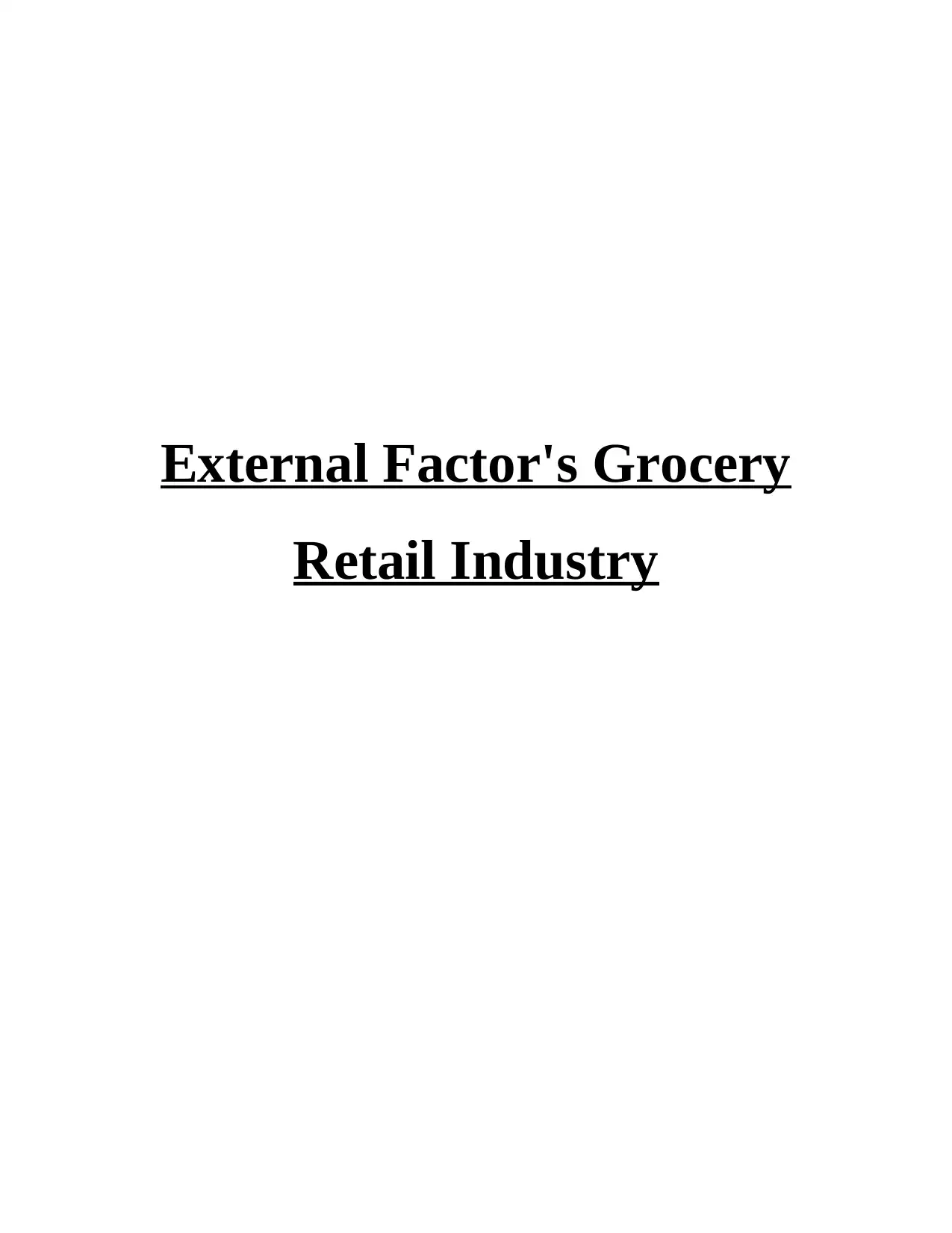
External Factor's Grocery
Retail Industry
Retail Industry
Secure Best Marks with AI Grader
Need help grading? Try our AI Grader for instant feedback on your assignments.
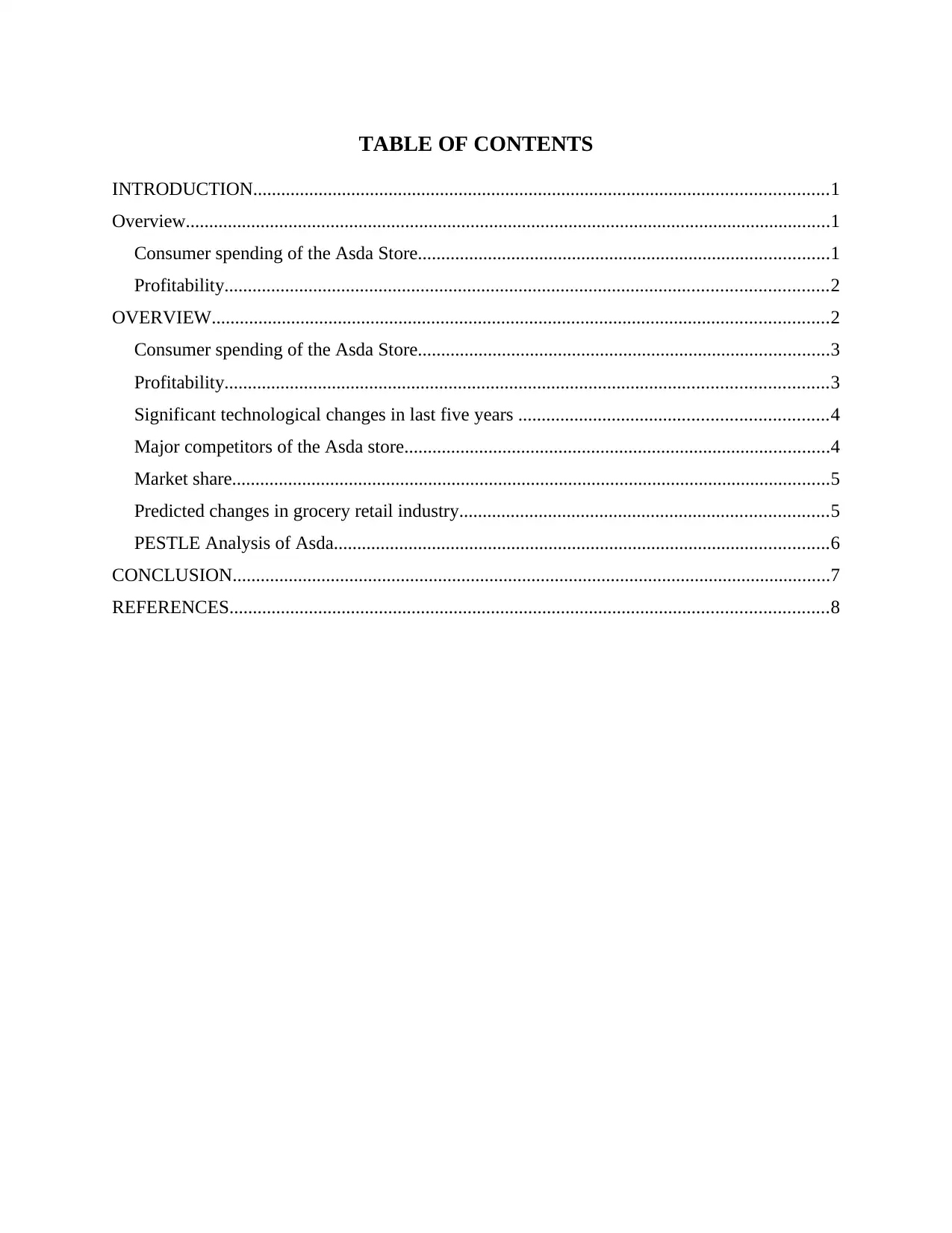
TABLE OF CONTENTS
INTRODUCTION...........................................................................................................................1
Overview..........................................................................................................................................1
Consumer spending of the Asda Store........................................................................................1
Profitability.................................................................................................................................2
OVERVIEW....................................................................................................................................2
Consumer spending of the Asda Store........................................................................................3
Profitability.................................................................................................................................3
Significant technological changes in last five years ..................................................................4
Major competitors of the Asda store...........................................................................................4
Market share................................................................................................................................5
Predicted changes in grocery retail industry...............................................................................5
PESTLE Analysis of Asda..........................................................................................................6
CONCLUSION................................................................................................................................7
REFERENCES................................................................................................................................8
INTRODUCTION...........................................................................................................................1
Overview..........................................................................................................................................1
Consumer spending of the Asda Store........................................................................................1
Profitability.................................................................................................................................2
OVERVIEW....................................................................................................................................2
Consumer spending of the Asda Store........................................................................................3
Profitability.................................................................................................................................3
Significant technological changes in last five years ..................................................................4
Major competitors of the Asda store...........................................................................................4
Market share................................................................................................................................5
Predicted changes in grocery retail industry...............................................................................5
PESTLE Analysis of Asda..........................................................................................................6
CONCLUSION................................................................................................................................7
REFERENCES................................................................................................................................8
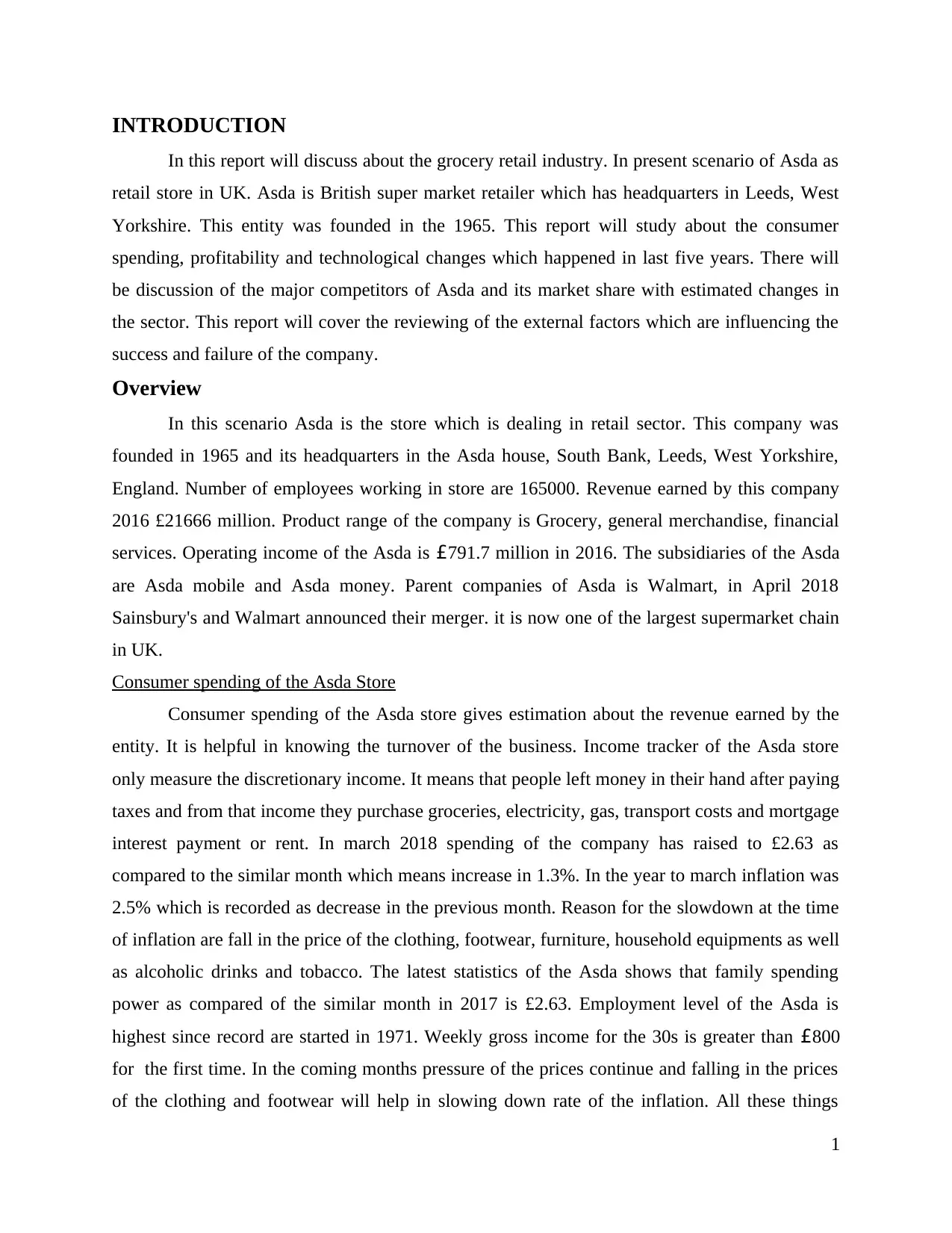
INTRODUCTION
In this report will discuss about the grocery retail industry. In present scenario of Asda as
retail store in UK. Asda is British super market retailer which has headquarters in Leeds, West
Yorkshire. This entity was founded in the 1965. This report will study about the consumer
spending, profitability and technological changes which happened in last five years. There will
be discussion of the major competitors of Asda and its market share with estimated changes in
the sector. This report will cover the reviewing of the external factors which are influencing the
success and failure of the company.
Overview
In this scenario Asda is the store which is dealing in retail sector. This company was
founded in 1965 and its headquarters in the Asda house, South Bank, Leeds, West Yorkshire,
England. Number of employees working in store are 165000. Revenue earned by this company
2016 £21666 million. Product range of the company is Grocery, general merchandise, financial
services. Operating income of the Asda is £791.7 million in 2016. The subsidiaries of the Asda
are Asda mobile and Asda money. Parent companies of Asda is Walmart, in April 2018
Sainsbury's and Walmart announced their merger. it is now one of the largest supermarket chain
in UK.
Consumer spending of the Asda Store
Consumer spending of the Asda store gives estimation about the revenue earned by the
entity. It is helpful in knowing the turnover of the business. Income tracker of the Asda store
only measure the discretionary income. It means that people left money in their hand after paying
taxes and from that income they purchase groceries, electricity, gas, transport costs and mortgage
interest payment or rent. In march 2018 spending of the company has raised to £2.63 as
compared to the similar month which means increase in 1.3%. In the year to march inflation was
2.5% which is recorded as decrease in the previous month. Reason for the slowdown at the time
of inflation are fall in the price of the clothing, footwear, furniture, household equipments as well
as alcoholic drinks and tobacco. The latest statistics of the Asda shows that family spending
power as compared of the similar month in 2017 is £2.63. Employment level of the Asda is
highest since record are started in 1971. Weekly gross income for the 30s is greater than £800
for the first time. In the coming months pressure of the prices continue and falling in the prices
of the clothing and footwear will help in slowing down rate of the inflation. All these things
1
In this report will discuss about the grocery retail industry. In present scenario of Asda as
retail store in UK. Asda is British super market retailer which has headquarters in Leeds, West
Yorkshire. This entity was founded in the 1965. This report will study about the consumer
spending, profitability and technological changes which happened in last five years. There will
be discussion of the major competitors of Asda and its market share with estimated changes in
the sector. This report will cover the reviewing of the external factors which are influencing the
success and failure of the company.
Overview
In this scenario Asda is the store which is dealing in retail sector. This company was
founded in 1965 and its headquarters in the Asda house, South Bank, Leeds, West Yorkshire,
England. Number of employees working in store are 165000. Revenue earned by this company
2016 £21666 million. Product range of the company is Grocery, general merchandise, financial
services. Operating income of the Asda is £791.7 million in 2016. The subsidiaries of the Asda
are Asda mobile and Asda money. Parent companies of Asda is Walmart, in April 2018
Sainsbury's and Walmart announced their merger. it is now one of the largest supermarket chain
in UK.
Consumer spending of the Asda Store
Consumer spending of the Asda store gives estimation about the revenue earned by the
entity. It is helpful in knowing the turnover of the business. Income tracker of the Asda store
only measure the discretionary income. It means that people left money in their hand after paying
taxes and from that income they purchase groceries, electricity, gas, transport costs and mortgage
interest payment or rent. In march 2018 spending of the company has raised to £2.63 as
compared to the similar month which means increase in 1.3%. In the year to march inflation was
2.5% which is recorded as decrease in the previous month. Reason for the slowdown at the time
of inflation are fall in the price of the clothing, footwear, furniture, household equipments as well
as alcoholic drinks and tobacco. The latest statistics of the Asda shows that family spending
power as compared of the similar month in 2017 is £2.63. Employment level of the Asda is
highest since record are started in 1971. Weekly gross income for the 30s is greater than £800
for the first time. In the coming months pressure of the prices continue and falling in the prices
of the clothing and footwear will help in slowing down rate of the inflation. All these things
1
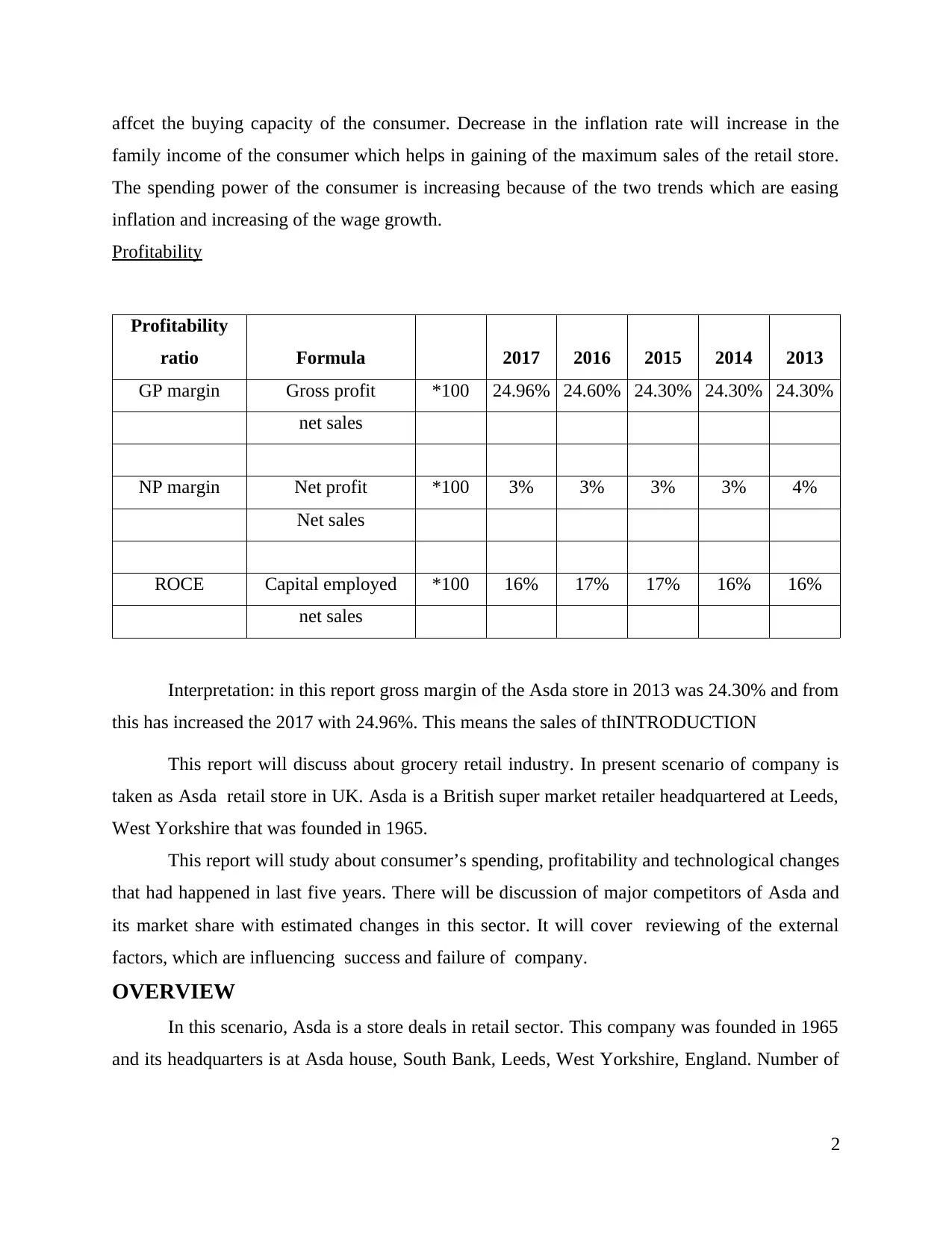
affcet the buying capacity of the consumer. Decrease in the inflation rate will increase in the
family income of the consumer which helps in gaining of the maximum sales of the retail store.
The spending power of the consumer is increasing because of the two trends which are easing
inflation and increasing of the wage growth.
Profitability
Profitability
ratio Formula 2017 2016 2015 2014 2013
GP margin Gross profit *100 24.96% 24.60% 24.30% 24.30% 24.30%
net sales
NP margin Net profit *100 3% 3% 3% 3% 4%
Net sales
ROCE Capital employed *100 16% 17% 17% 16% 16%
net sales
Interpretation: in this report gross margin of the Asda store in 2013 was 24.30% and from
this has increased the 2017 with 24.96%. This means the sales of thINTRODUCTION
This report will discuss about grocery retail industry. In present scenario of company is
taken as Asda retail store in UK. Asda is a British super market retailer headquartered at Leeds,
West Yorkshire that was founded in 1965.
This report will study about consumer’s spending, profitability and technological changes
that had happened in last five years. There will be discussion of major competitors of Asda and
its market share with estimated changes in this sector. It will cover reviewing of the external
factors, which are influencing success and failure of company.
OVERVIEW
In this scenario, Asda is a store deals in retail sector. This company was founded in 1965
and its headquarters is at Asda house, South Bank, Leeds, West Yorkshire, England. Number of
2
family income of the consumer which helps in gaining of the maximum sales of the retail store.
The spending power of the consumer is increasing because of the two trends which are easing
inflation and increasing of the wage growth.
Profitability
Profitability
ratio Formula 2017 2016 2015 2014 2013
GP margin Gross profit *100 24.96% 24.60% 24.30% 24.30% 24.30%
net sales
NP margin Net profit *100 3% 3% 3% 3% 4%
Net sales
ROCE Capital employed *100 16% 17% 17% 16% 16%
net sales
Interpretation: in this report gross margin of the Asda store in 2013 was 24.30% and from
this has increased the 2017 with 24.96%. This means the sales of thINTRODUCTION
This report will discuss about grocery retail industry. In present scenario of company is
taken as Asda retail store in UK. Asda is a British super market retailer headquartered at Leeds,
West Yorkshire that was founded in 1965.
This report will study about consumer’s spending, profitability and technological changes
that had happened in last five years. There will be discussion of major competitors of Asda and
its market share with estimated changes in this sector. It will cover reviewing of the external
factors, which are influencing success and failure of company.
OVERVIEW
In this scenario, Asda is a store deals in retail sector. This company was founded in 1965
and its headquarters is at Asda house, South Bank, Leeds, West Yorkshire, England. Number of
2
Secure Best Marks with AI Grader
Need help grading? Try our AI Grader for instant feedback on your assignments.

employees working in this store are 165000. Revenue earned by this company in 2016 was
£21666 million.
Product range of this company is grocery, general merchandise, and financial services.
Operating income of Asda is £791.7 million in 2016. The subsidiaries of Asda are Asda mobile
and Asda money. Parent company of Asda is Walmart; in April 2018, Sainsbury's and Walmart
announced their merger. It is now one of the largest supermarket chains in UK.
Consumer spending of the Asda Store
Consumer’s spending of Asda store gives estimation about revenue earned by the
business. It is helpful in knowing turnover of business. Income tracker of Asda store only
measures the discretionary income (Renton and et.al., 2016). It means that people have money in
their hands after paying taxes and from that income they purchase groceries, electricity, gas,
transport costs and mortgage interest payment or rent.
In March 2018, spending of this company has been raised to £2.63 as compared in the
similar month that means increase in 1.3%. In the year to march inflation rate was 2.5% which is
recorded as decrease in the previous month. Reason for slowdown at the time of inflation is fall
in price of clothing, footwear, furniture, household equipments as well as alcoholic drinks and
tobacco. The latest statistics of Asda shows that family-spending power as compared of the
similar month in 2017 is £2.63 (Meyer and et.al., 2017).
Employment level of Asda is high, since record are started in 1971. Weekly gross income
for 30s is greater than £800 for the first time. In coming months, pressure of prices continues and
falling in the prices of the clothing and footwear will help in slowing down rate of inflation. All
these things affect the buying capacity of the consumer. Decrease in inflation rate will increase
family income of consumer, which helps in gaining maximum sales of the retail store. The
spending power of consumer is increasing because of two trends such as increasing inflation and
increasing of wage growth.
Profitability
Profitability
Ratio Formula 2017 2016 2015 2014 2013
GP Margin Gross Profit *100 24.96% 24.60% 24.30% 24.30% 24.30%
3
£21666 million.
Product range of this company is grocery, general merchandise, and financial services.
Operating income of Asda is £791.7 million in 2016. The subsidiaries of Asda are Asda mobile
and Asda money. Parent company of Asda is Walmart; in April 2018, Sainsbury's and Walmart
announced their merger. It is now one of the largest supermarket chains in UK.
Consumer spending of the Asda Store
Consumer’s spending of Asda store gives estimation about revenue earned by the
business. It is helpful in knowing turnover of business. Income tracker of Asda store only
measures the discretionary income (Renton and et.al., 2016). It means that people have money in
their hands after paying taxes and from that income they purchase groceries, electricity, gas,
transport costs and mortgage interest payment or rent.
In March 2018, spending of this company has been raised to £2.63 as compared in the
similar month that means increase in 1.3%. In the year to march inflation rate was 2.5% which is
recorded as decrease in the previous month. Reason for slowdown at the time of inflation is fall
in price of clothing, footwear, furniture, household equipments as well as alcoholic drinks and
tobacco. The latest statistics of Asda shows that family-spending power as compared of the
similar month in 2017 is £2.63 (Meyer and et.al., 2017).
Employment level of Asda is high, since record are started in 1971. Weekly gross income
for 30s is greater than £800 for the first time. In coming months, pressure of prices continues and
falling in the prices of the clothing and footwear will help in slowing down rate of inflation. All
these things affect the buying capacity of the consumer. Decrease in inflation rate will increase
family income of consumer, which helps in gaining maximum sales of the retail store. The
spending power of consumer is increasing because of two trends such as increasing inflation and
increasing of wage growth.
Profitability
Profitability
Ratio Formula 2017 2016 2015 2014 2013
GP Margin Gross Profit *100 24.96% 24.60% 24.30% 24.30% 24.30%
3
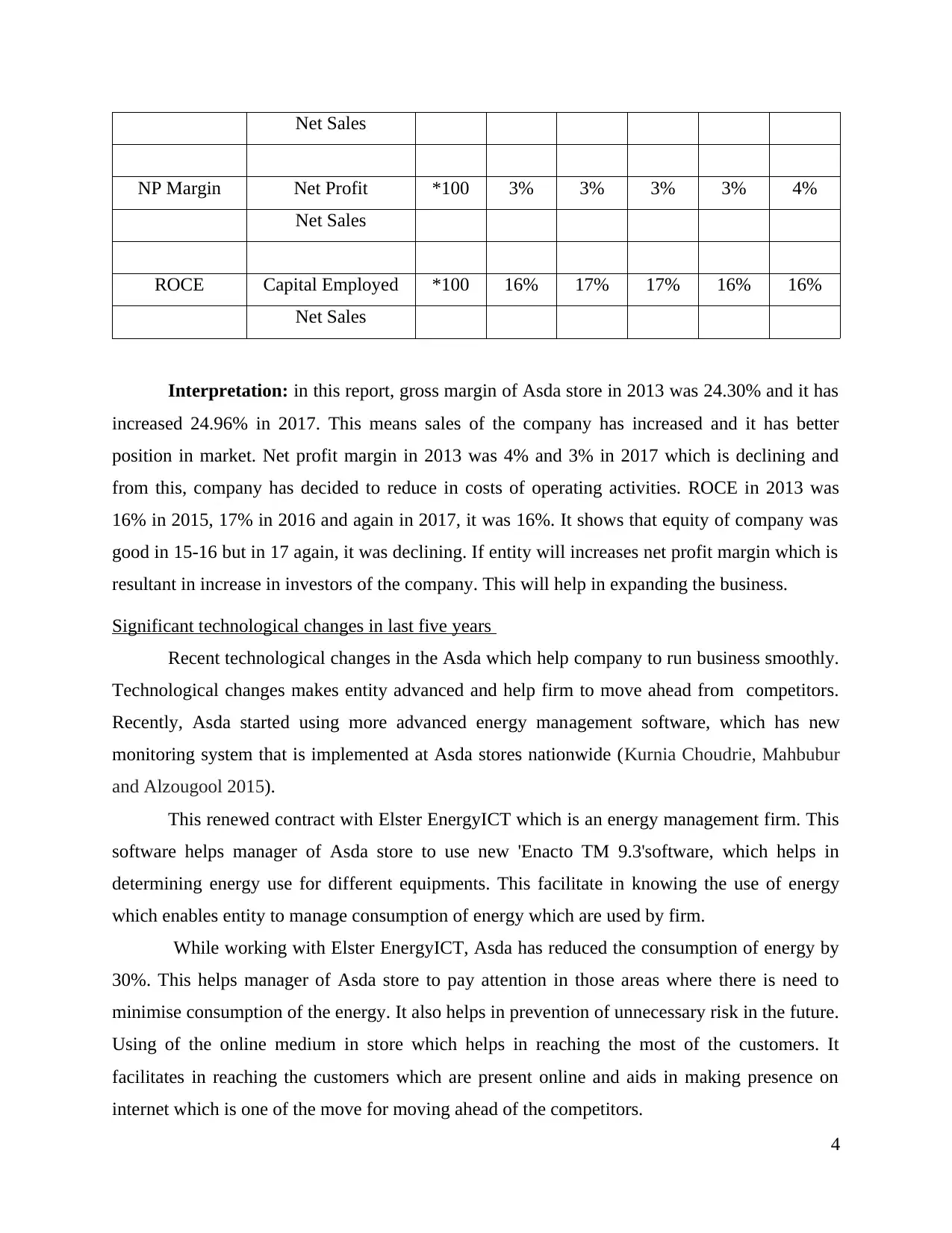
Net Sales
NP Margin Net Profit *100 3% 3% 3% 3% 4%
Net Sales
ROCE Capital Employed *100 16% 17% 17% 16% 16%
Net Sales
Interpretation: in this report, gross margin of Asda store in 2013 was 24.30% and it has
increased 24.96% in 2017. This means sales of the company has increased and it has better
position in market. Net profit margin in 2013 was 4% and 3% in 2017 which is declining and
from this, company has decided to reduce in costs of operating activities. ROCE in 2013 was
16% in 2015, 17% in 2016 and again in 2017, it was 16%. It shows that equity of company was
good in 15-16 but in 17 again, it was declining. If entity will increases net profit margin which is
resultant in increase in investors of the company. This will help in expanding the business.
Significant technological changes in last five years
Recent technological changes in the Asda which help company to run business smoothly.
Technological changes makes entity advanced and help firm to move ahead from competitors.
Recently, Asda started using more advanced energy management software, which has new
monitoring system that is implemented at Asda stores nationwide (Kurnia Choudrie, Mahbubur
and Alzougool 2015).
This renewed contract with Elster EnergyICT which is an energy management firm. This
software helps manager of Asda store to use new 'Enacto TM 9.3'software, which helps in
determining energy use for different equipments. This facilitate in knowing the use of energy
which enables entity to manage consumption of energy which are used by firm.
While working with Elster EnergyICT, Asda has reduced the consumption of energy by
30%. This helps manager of Asda store to pay attention in those areas where there is need to
minimise consumption of the energy. It also helps in prevention of unnecessary risk in the future.
Using of the online medium in store which helps in reaching the most of the customers. It
facilitates in reaching the customers which are present online and aids in making presence on
internet which is one of the move for moving ahead of the competitors.
4
NP Margin Net Profit *100 3% 3% 3% 3% 4%
Net Sales
ROCE Capital Employed *100 16% 17% 17% 16% 16%
Net Sales
Interpretation: in this report, gross margin of Asda store in 2013 was 24.30% and it has
increased 24.96% in 2017. This means sales of the company has increased and it has better
position in market. Net profit margin in 2013 was 4% and 3% in 2017 which is declining and
from this, company has decided to reduce in costs of operating activities. ROCE in 2013 was
16% in 2015, 17% in 2016 and again in 2017, it was 16%. It shows that equity of company was
good in 15-16 but in 17 again, it was declining. If entity will increases net profit margin which is
resultant in increase in investors of the company. This will help in expanding the business.
Significant technological changes in last five years
Recent technological changes in the Asda which help company to run business smoothly.
Technological changes makes entity advanced and help firm to move ahead from competitors.
Recently, Asda started using more advanced energy management software, which has new
monitoring system that is implemented at Asda stores nationwide (Kurnia Choudrie, Mahbubur
and Alzougool 2015).
This renewed contract with Elster EnergyICT which is an energy management firm. This
software helps manager of Asda store to use new 'Enacto TM 9.3'software, which helps in
determining energy use for different equipments. This facilitate in knowing the use of energy
which enables entity to manage consumption of energy which are used by firm.
While working with Elster EnergyICT, Asda has reduced the consumption of energy by
30%. This helps manager of Asda store to pay attention in those areas where there is need to
minimise consumption of the energy. It also helps in prevention of unnecessary risk in the future.
Using of the online medium in store which helps in reaching the most of the customers. It
facilitates in reaching the customers which are present online and aids in making presence on
internet which is one of the move for moving ahead of the competitors.
4
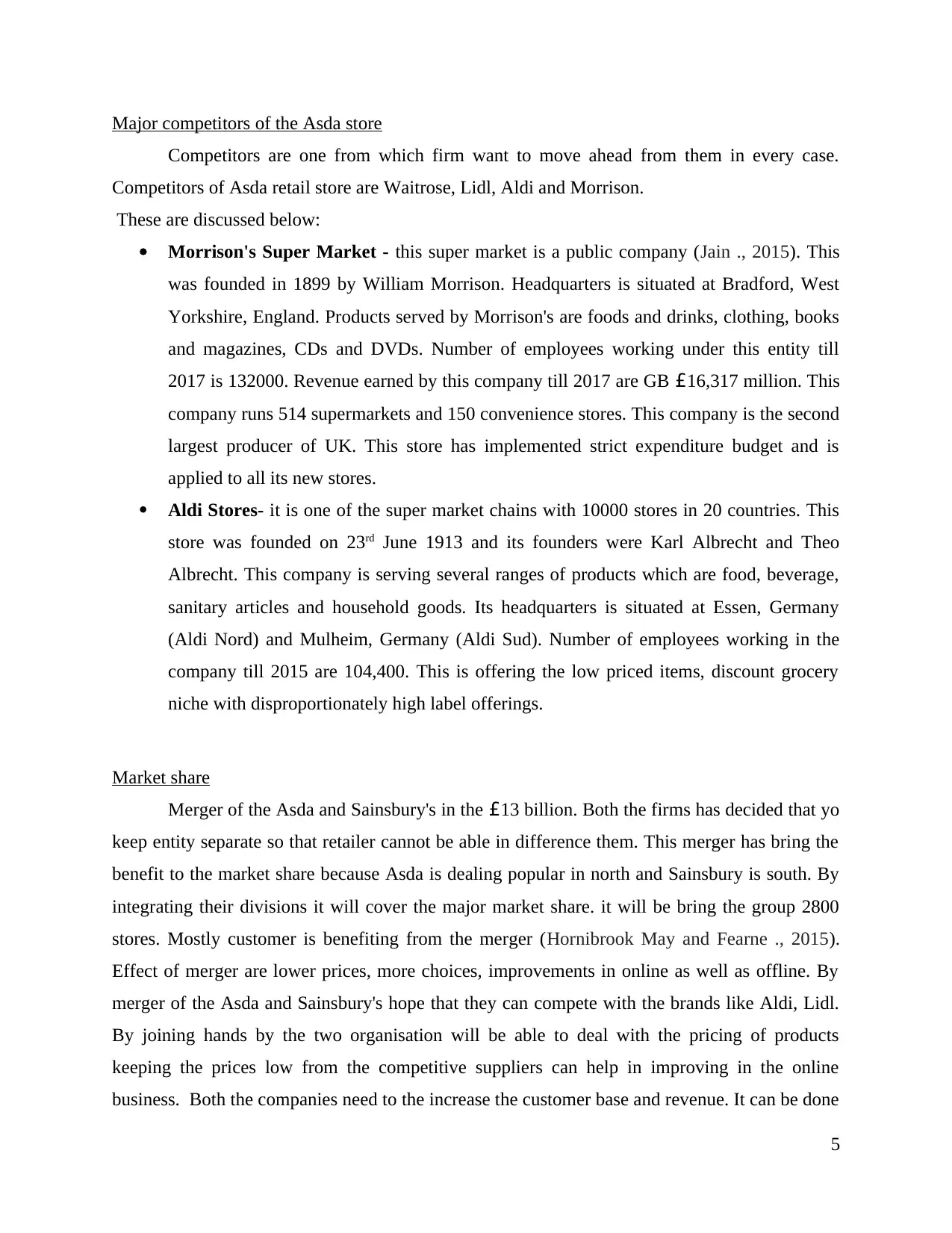
Major competitors of the Asda store
Competitors are one from which firm want to move ahead from them in every case.
Competitors of Asda retail store are Waitrose, Lidl, Aldi and Morrison.
These are discussed below:
Morrison's Super Market - this super market is a public company (Jain ., 2015). This
was founded in 1899 by William Morrison. Headquarters is situated at Bradford, West
Yorkshire, England. Products served by Morrison's are foods and drinks, clothing, books
and magazines, CDs and DVDs. Number of employees working under this entity till
2017 is 132000. Revenue earned by this company till 2017 are GB £16,317 million. This
company runs 514 supermarkets and 150 convenience stores. This company is the second
largest producer of UK. This store has implemented strict expenditure budget and is
applied to all its new stores.
Aldi Stores- it is one of the super market chains with 10000 stores in 20 countries. This
store was founded on 23rd June 1913 and its founders were Karl Albrecht and Theo
Albrecht. This company is serving several ranges of products which are food, beverage,
sanitary articles and household goods. Its headquarters is situated at Essen, Germany
(Aldi Nord) and Mulheim, Germany (Aldi Sud). Number of employees working in the
company till 2015 are 104,400. This is offering the low priced items, discount grocery
niche with disproportionately high label offerings.
Market share
Merger of the Asda and Sainsbury's in the £13 billion. Both the firms has decided that yo
keep entity separate so that retailer cannot be able in difference them. This merger has bring the
benefit to the market share because Asda is dealing popular in north and Sainsbury is south. By
integrating their divisions it will cover the major market share. it will be bring the group 2800
stores. Mostly customer is benefiting from the merger (Hornibrook May and Fearne ., 2015).
Effect of merger are lower prices, more choices, improvements in online as well as offline. By
merger of the Asda and Sainsbury's hope that they can compete with the brands like Aldi, Lidl.
By joining hands by the two organisation will be able to deal with the pricing of products
keeping the prices low from the competitive suppliers can help in improving in the online
business. Both the companies need to the increase the customer base and revenue. It can be done
5
Competitors are one from which firm want to move ahead from them in every case.
Competitors of Asda retail store are Waitrose, Lidl, Aldi and Morrison.
These are discussed below:
Morrison's Super Market - this super market is a public company (Jain ., 2015). This
was founded in 1899 by William Morrison. Headquarters is situated at Bradford, West
Yorkshire, England. Products served by Morrison's are foods and drinks, clothing, books
and magazines, CDs and DVDs. Number of employees working under this entity till
2017 is 132000. Revenue earned by this company till 2017 are GB £16,317 million. This
company runs 514 supermarkets and 150 convenience stores. This company is the second
largest producer of UK. This store has implemented strict expenditure budget and is
applied to all its new stores.
Aldi Stores- it is one of the super market chains with 10000 stores in 20 countries. This
store was founded on 23rd June 1913 and its founders were Karl Albrecht and Theo
Albrecht. This company is serving several ranges of products which are food, beverage,
sanitary articles and household goods. Its headquarters is situated at Essen, Germany
(Aldi Nord) and Mulheim, Germany (Aldi Sud). Number of employees working in the
company till 2015 are 104,400. This is offering the low priced items, discount grocery
niche with disproportionately high label offerings.
Market share
Merger of the Asda and Sainsbury's in the £13 billion. Both the firms has decided that yo
keep entity separate so that retailer cannot be able in difference them. This merger has bring the
benefit to the market share because Asda is dealing popular in north and Sainsbury is south. By
integrating their divisions it will cover the major market share. it will be bring the group 2800
stores. Mostly customer is benefiting from the merger (Hornibrook May and Fearne ., 2015).
Effect of merger are lower prices, more choices, improvements in online as well as offline. By
merger of the Asda and Sainsbury's hope that they can compete with the brands like Aldi, Lidl.
By joining hands by the two organisation will be able to deal with the pricing of products
keeping the prices low from the competitive suppliers can help in improving in the online
business. Both the companies need to the increase the customer base and revenue. It can be done
5
Paraphrase This Document
Need a fresh take? Get an instant paraphrase of this document with our AI Paraphraser
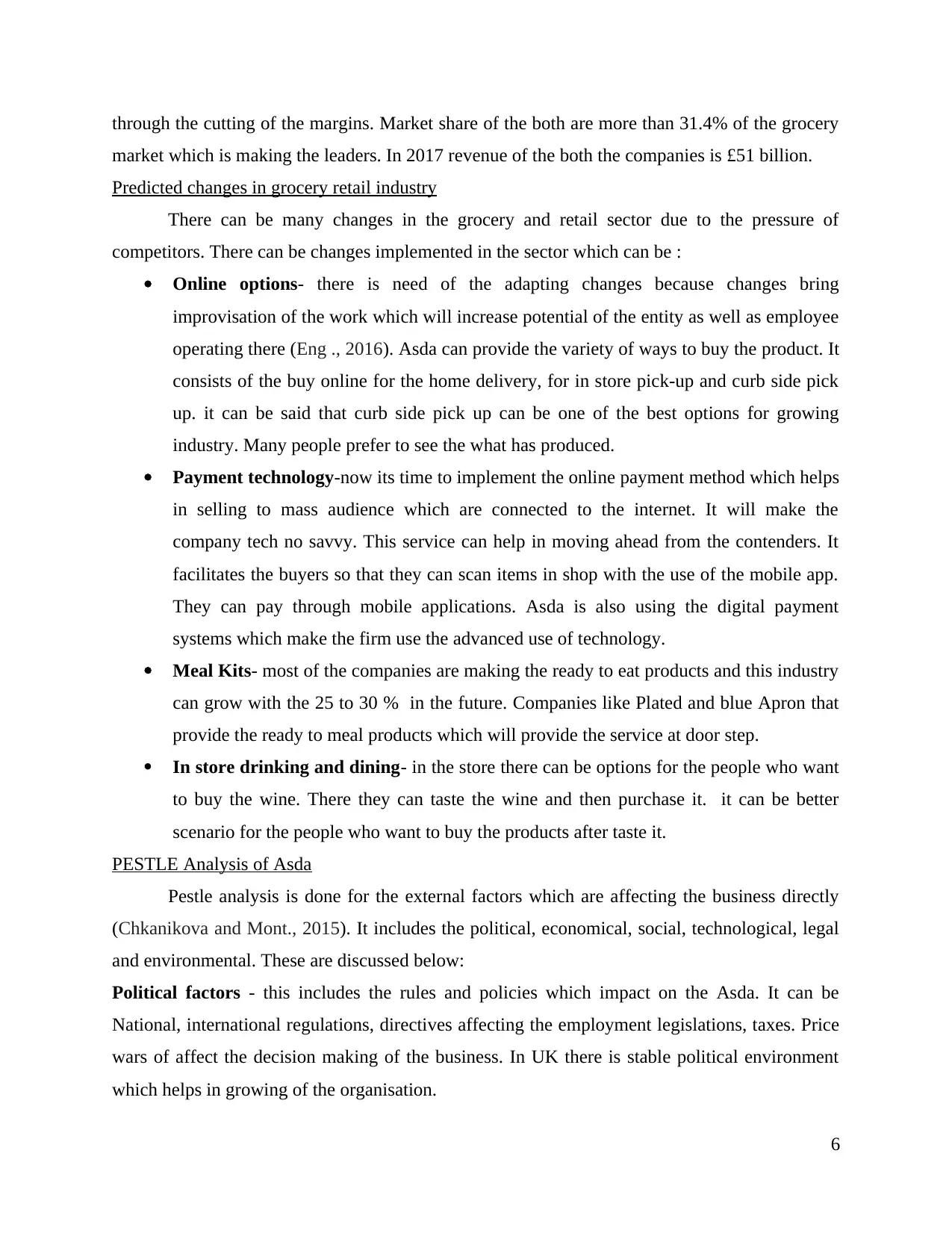
through the cutting of the margins. Market share of the both are more than 31.4% of the grocery
market which is making the leaders. In 2017 revenue of the both the companies is £51 billion.
Predicted changes in grocery retail industry
There can be many changes in the grocery and retail sector due to the pressure of
competitors. There can be changes implemented in the sector which can be :
Online options- there is need of the adapting changes because changes bring
improvisation of the work which will increase potential of the entity as well as employee
operating there (Eng ., 2016). Asda can provide the variety of ways to buy the product. It
consists of the buy online for the home delivery, for in store pick-up and curb side pick
up. it can be said that curb side pick up can be one of the best options for growing
industry. Many people prefer to see the what has produced.
Payment technology-now its time to implement the online payment method which helps
in selling to mass audience which are connected to the internet. It will make the
company tech no savvy. This service can help in moving ahead from the contenders. It
facilitates the buyers so that they can scan items in shop with the use of the mobile app.
They can pay through mobile applications. Asda is also using the digital payment
systems which make the firm use the advanced use of technology.
Meal Kits- most of the companies are making the ready to eat products and this industry
can grow with the 25 to 30 % in the future. Companies like Plated and blue Apron that
provide the ready to meal products which will provide the service at door step.
In store drinking and dining- in the store there can be options for the people who want
to buy the wine. There they can taste the wine and then purchase it. it can be better
scenario for the people who want to buy the products after taste it.
PESTLE Analysis of Asda
Pestle analysis is done for the external factors which are affecting the business directly
(Chkanikova and Mont., 2015). It includes the political, economical, social, technological, legal
and environmental. These are discussed below:
Political factors - this includes the rules and policies which impact on the Asda. It can be
National, international regulations, directives affecting the employment legislations, taxes. Price
wars of affect the decision making of the business. In UK there is stable political environment
which helps in growing of the organisation.
6
market which is making the leaders. In 2017 revenue of the both the companies is £51 billion.
Predicted changes in grocery retail industry
There can be many changes in the grocery and retail sector due to the pressure of
competitors. There can be changes implemented in the sector which can be :
Online options- there is need of the adapting changes because changes bring
improvisation of the work which will increase potential of the entity as well as employee
operating there (Eng ., 2016). Asda can provide the variety of ways to buy the product. It
consists of the buy online for the home delivery, for in store pick-up and curb side pick
up. it can be said that curb side pick up can be one of the best options for growing
industry. Many people prefer to see the what has produced.
Payment technology-now its time to implement the online payment method which helps
in selling to mass audience which are connected to the internet. It will make the
company tech no savvy. This service can help in moving ahead from the contenders. It
facilitates the buyers so that they can scan items in shop with the use of the mobile app.
They can pay through mobile applications. Asda is also using the digital payment
systems which make the firm use the advanced use of technology.
Meal Kits- most of the companies are making the ready to eat products and this industry
can grow with the 25 to 30 % in the future. Companies like Plated and blue Apron that
provide the ready to meal products which will provide the service at door step.
In store drinking and dining- in the store there can be options for the people who want
to buy the wine. There they can taste the wine and then purchase it. it can be better
scenario for the people who want to buy the products after taste it.
PESTLE Analysis of Asda
Pestle analysis is done for the external factors which are affecting the business directly
(Chkanikova and Mont., 2015). It includes the political, economical, social, technological, legal
and environmental. These are discussed below:
Political factors - this includes the rules and policies which impact on the Asda. It can be
National, international regulations, directives affecting the employment legislations, taxes. Price
wars of affect the decision making of the business. In UK there is stable political environment
which helps in growing of the organisation.
6
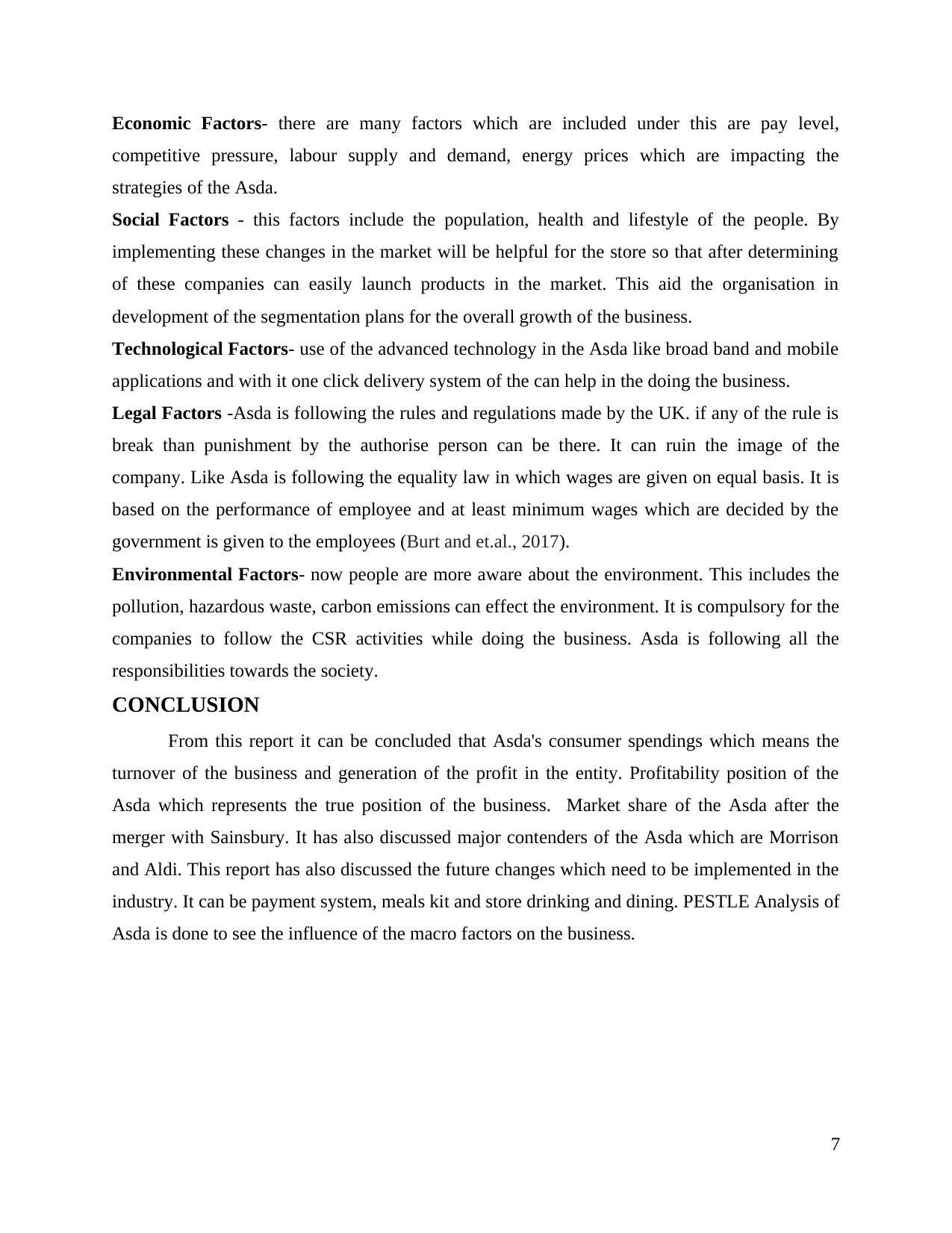
Economic Factors- there are many factors which are included under this are pay level,
competitive pressure, labour supply and demand, energy prices which are impacting the
strategies of the Asda.
Social Factors - this factors include the population, health and lifestyle of the people. By
implementing these changes in the market will be helpful for the store so that after determining
of these companies can easily launch products in the market. This aid the organisation in
development of the segmentation plans for the overall growth of the business.
Technological Factors- use of the advanced technology in the Asda like broad band and mobile
applications and with it one click delivery system of the can help in the doing the business.
Legal Factors -Asda is following the rules and regulations made by the UK. if any of the rule is
break than punishment by the authorise person can be there. It can ruin the image of the
company. Like Asda is following the equality law in which wages are given on equal basis. It is
based on the performance of employee and at least minimum wages which are decided by the
government is given to the employees (Burt and et.al., 2017).
Environmental Factors- now people are more aware about the environment. This includes the
pollution, hazardous waste, carbon emissions can effect the environment. It is compulsory for the
companies to follow the CSR activities while doing the business. Asda is following all the
responsibilities towards the society.
CONCLUSION
From this report it can be concluded that Asda's consumer spendings which means the
turnover of the business and generation of the profit in the entity. Profitability position of the
Asda which represents the true position of the business. Market share of the Asda after the
merger with Sainsbury. It has also discussed major contenders of the Asda which are Morrison
and Aldi. This report has also discussed the future changes which need to be implemented in the
industry. It can be payment system, meals kit and store drinking and dining. PESTLE Analysis of
Asda is done to see the influence of the macro factors on the business.
7
competitive pressure, labour supply and demand, energy prices which are impacting the
strategies of the Asda.
Social Factors - this factors include the population, health and lifestyle of the people. By
implementing these changes in the market will be helpful for the store so that after determining
of these companies can easily launch products in the market. This aid the organisation in
development of the segmentation plans for the overall growth of the business.
Technological Factors- use of the advanced technology in the Asda like broad band and mobile
applications and with it one click delivery system of the can help in the doing the business.
Legal Factors -Asda is following the rules and regulations made by the UK. if any of the rule is
break than punishment by the authorise person can be there. It can ruin the image of the
company. Like Asda is following the equality law in which wages are given on equal basis. It is
based on the performance of employee and at least minimum wages which are decided by the
government is given to the employees (Burt and et.al., 2017).
Environmental Factors- now people are more aware about the environment. This includes the
pollution, hazardous waste, carbon emissions can effect the environment. It is compulsory for the
companies to follow the CSR activities while doing the business. Asda is following all the
responsibilities towards the society.
CONCLUSION
From this report it can be concluded that Asda's consumer spendings which means the
turnover of the business and generation of the profit in the entity. Profitability position of the
Asda which represents the true position of the business. Market share of the Asda after the
merger with Sainsbury. It has also discussed major contenders of the Asda which are Morrison
and Aldi. This report has also discussed the future changes which need to be implemented in the
industry. It can be payment system, meals kit and store drinking and dining. PESTLE Analysis of
Asda is done to see the influence of the macro factors on the business.
7
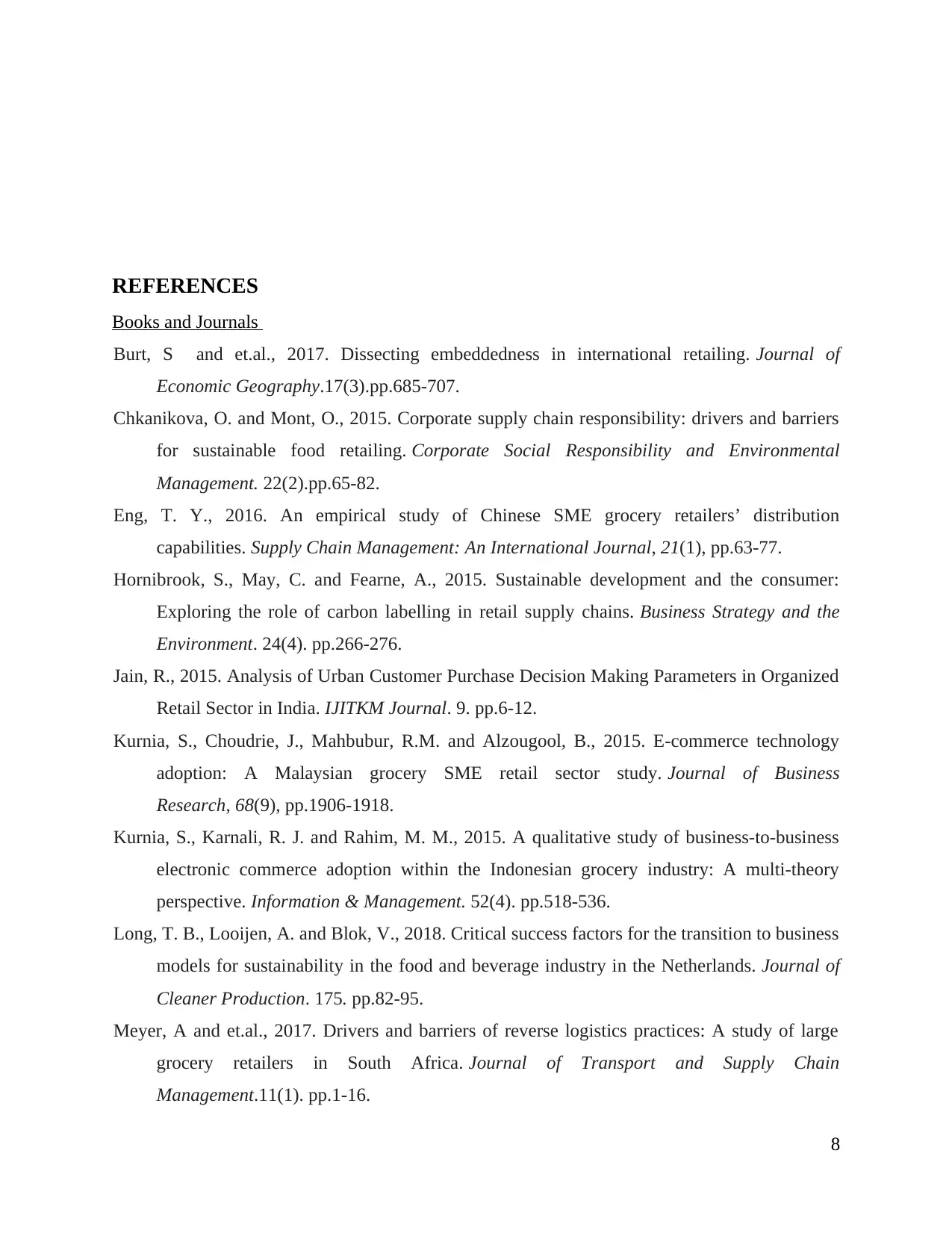
REFERENCES
Books and Journals
Burt, S and et.al., 2017. Dissecting embeddedness in international retailing. Journal of
Economic Geography.17(3).pp.685-707.
Chkanikova, O. and Mont, O., 2015. Corporate supply chain responsibility: drivers and barriers
for sustainable food retailing. Corporate Social Responsibility and Environmental
Management. 22(2).pp.65-82.
Eng, T. Y., 2016. An empirical study of Chinese SME grocery retailers’ distribution
capabilities. Supply Chain Management: An International Journal, 21(1), pp.63-77.
Hornibrook, S., May, C. and Fearne, A., 2015. Sustainable development and the consumer:
Exploring the role of carbon labelling in retail supply chains. Business Strategy and the
Environment. 24(4). pp.266-276.
Jain, R., 2015. Analysis of Urban Customer Purchase Decision Making Parameters in Organized
Retail Sector in India. IJITKM Journal. 9. pp.6-12.
Kurnia, S., Choudrie, J., Mahbubur, R.M. and Alzougool, B., 2015. E-commerce technology
adoption: A Malaysian grocery SME retail sector study. Journal of Business
Research, 68(9), pp.1906-1918.
Kurnia, S., Karnali, R. J. and Rahim, M. M., 2015. A qualitative study of business-to-business
electronic commerce adoption within the Indonesian grocery industry: A multi-theory
perspective. Information & Management. 52(4). pp.518-536.
Long, T. B., Looijen, A. and Blok, V., 2018. Critical success factors for the transition to business
models for sustainability in the food and beverage industry in the Netherlands. Journal of
Cleaner Production. 175. pp.82-95.
Meyer, A and et.al., 2017. Drivers and barriers of reverse logistics practices: A study of large
grocery retailers in South Africa. Journal of Transport and Supply Chain
Management.11(1). pp.1-16.
8
Books and Journals
Burt, S and et.al., 2017. Dissecting embeddedness in international retailing. Journal of
Economic Geography.17(3).pp.685-707.
Chkanikova, O. and Mont, O., 2015. Corporate supply chain responsibility: drivers and barriers
for sustainable food retailing. Corporate Social Responsibility and Environmental
Management. 22(2).pp.65-82.
Eng, T. Y., 2016. An empirical study of Chinese SME grocery retailers’ distribution
capabilities. Supply Chain Management: An International Journal, 21(1), pp.63-77.
Hornibrook, S., May, C. and Fearne, A., 2015. Sustainable development and the consumer:
Exploring the role of carbon labelling in retail supply chains. Business Strategy and the
Environment. 24(4). pp.266-276.
Jain, R., 2015. Analysis of Urban Customer Purchase Decision Making Parameters in Organized
Retail Sector in India. IJITKM Journal. 9. pp.6-12.
Kurnia, S., Choudrie, J., Mahbubur, R.M. and Alzougool, B., 2015. E-commerce technology
adoption: A Malaysian grocery SME retail sector study. Journal of Business
Research, 68(9), pp.1906-1918.
Kurnia, S., Karnali, R. J. and Rahim, M. M., 2015. A qualitative study of business-to-business
electronic commerce adoption within the Indonesian grocery industry: A multi-theory
perspective. Information & Management. 52(4). pp.518-536.
Long, T. B., Looijen, A. and Blok, V., 2018. Critical success factors for the transition to business
models for sustainability in the food and beverage industry in the Netherlands. Journal of
Cleaner Production. 175. pp.82-95.
Meyer, A and et.al., 2017. Drivers and barriers of reverse logistics practices: A study of large
grocery retailers in South Africa. Journal of Transport and Supply Chain
Management.11(1). pp.1-16.
8
Secure Best Marks with AI Grader
Need help grading? Try our AI Grader for instant feedback on your assignments.
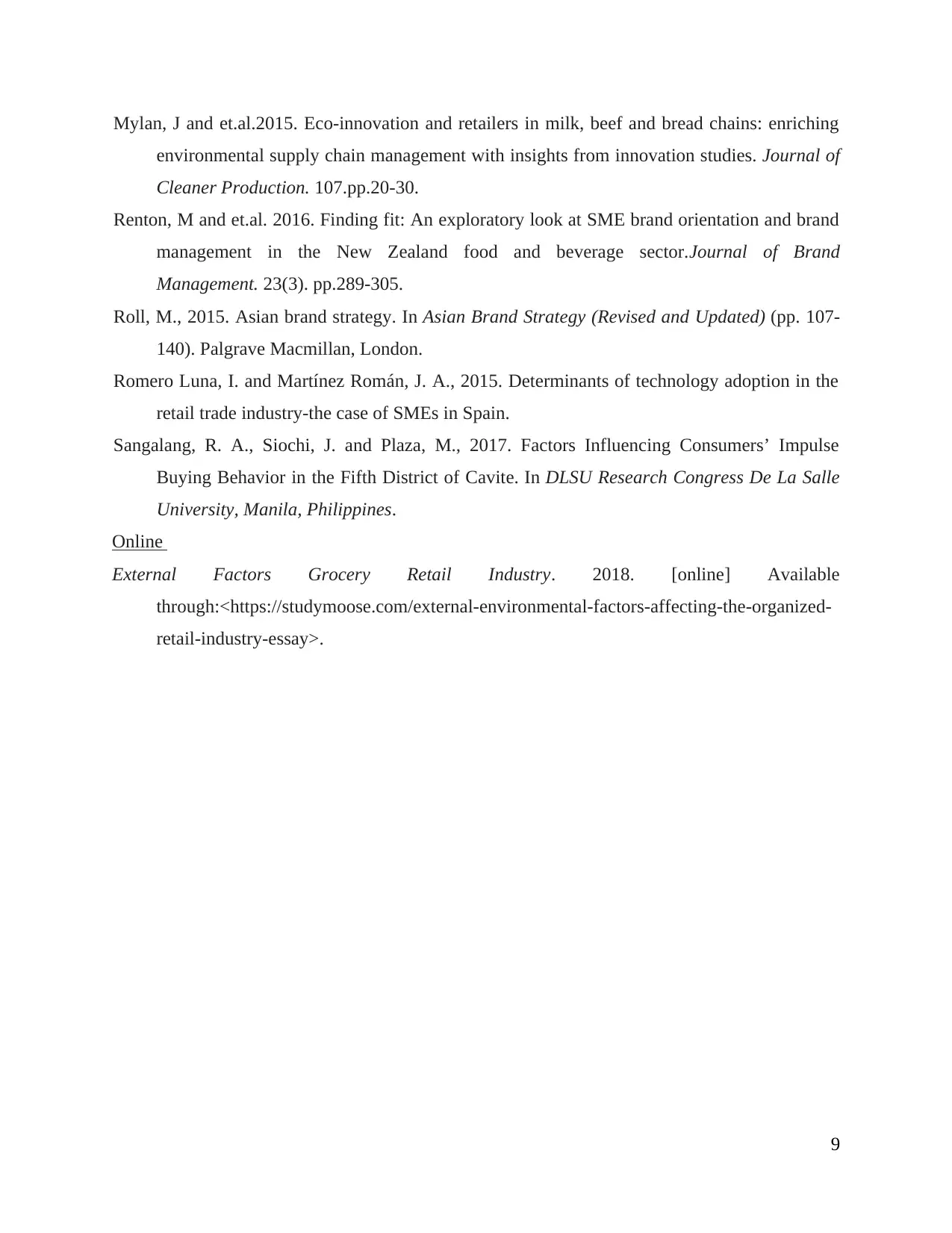
Mylan, J and et.al.2015. Eco-innovation and retailers in milk, beef and bread chains: enriching
environmental supply chain management with insights from innovation studies. Journal of
Cleaner Production. 107.pp.20-30.
Renton, M and et.al. 2016. Finding fit: An exploratory look at SME brand orientation and brand
management in the New Zealand food and beverage sector.Journal of Brand
Management. 23(3). pp.289-305.
Roll, M., 2015. Asian brand strategy. In Asian Brand Strategy (Revised and Updated) (pp. 107-
140). Palgrave Macmillan, London.
Romero Luna, I. and Martínez Román, J. A., 2015. Determinants of technology adoption in the
retail trade industry-the case of SMEs in Spain.
Sangalang, R. A., Siochi, J. and Plaza, M., 2017. Factors Influencing Consumers’ Impulse
Buying Behavior in the Fifth District of Cavite. In DLSU Research Congress De La Salle
University, Manila, Philippines.
Online
External Factors Grocery Retail Industry. 2018. [online] Available
through:<https://studymoose.com/external-environmental-factors-affecting-the-organized-
retail-industry-essay>.
9
environmental supply chain management with insights from innovation studies. Journal of
Cleaner Production. 107.pp.20-30.
Renton, M and et.al. 2016. Finding fit: An exploratory look at SME brand orientation and brand
management in the New Zealand food and beverage sector.Journal of Brand
Management. 23(3). pp.289-305.
Roll, M., 2015. Asian brand strategy. In Asian Brand Strategy (Revised and Updated) (pp. 107-
140). Palgrave Macmillan, London.
Romero Luna, I. and Martínez Román, J. A., 2015. Determinants of technology adoption in the
retail trade industry-the case of SMEs in Spain.
Sangalang, R. A., Siochi, J. and Plaza, M., 2017. Factors Influencing Consumers’ Impulse
Buying Behavior in the Fifth District of Cavite. In DLSU Research Congress De La Salle
University, Manila, Philippines.
Online
External Factors Grocery Retail Industry. 2018. [online] Available
through:<https://studymoose.com/external-environmental-factors-affecting-the-organized-
retail-industry-essay>.
9
1 out of 11
Related Documents
Your All-in-One AI-Powered Toolkit for Academic Success.
+13062052269
info@desklib.com
Available 24*7 on WhatsApp / Email
![[object Object]](/_next/static/media/star-bottom.7253800d.svg)
Unlock your academic potential
© 2024 | Zucol Services PVT LTD | All rights reserved.





